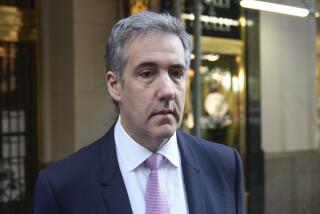Defense Rests in First Sniper Trial
- Share via
VIRGINIA BEACH, Va. — Lawyers for sniper suspect John Allen Muhammad on Wednesday presented a skeletal defense, finishing in three hours after challenging little of the prosecution’s evidence in the Washington, D.C.-area serial murder case.
Peter D. Greenspun and Jonathan Shapiro, Muhammad’s defense team, called only five witnesses and displayed a handful of photographs -- an effort dwarfed by the 400 evidence exhibits and 120 witnesses used by prosecutors over the last four weeks to build a massive circumstantial case for a murder conviction. They spent most of their time trying to undermine prosecution accounts that repeatedly had placed Muhammad near sniper killing scenes.
Prince William County Circuit Judge LeRoy F. Millette Jr. said closing arguments would start today.
The defense’s key witness Wednesday was a private investigator who sought to discredit the testimony of a Maryland chiropractor who insisted he had seen Muhammad and his alleged accomplice, Lee Boyd Malvo, in a Chevrolet Caprice minutes after sniper victim Iran Brown was wounded Oct. 7, 2002, near the front entrance of his Maryland middle school.
John Nenna disputed Dr. Gerald Driscoll’s testimony that he could have recognized Muhammad from 92 feet away as both men sat in their cars. Shapiro also tried to cast doubt on Driscoll’s statement that the sun had reflected on Muhammad’s face. The defense lawyer noted caustically that sunrise was still several minutes away when the chiropractor claimed to have seen Muhammad.
Earlier in the day, Millette had rejected a defense request to dismiss the murder charges against Muhammad, ruling that the government’s case was persuasive and met proper legal standards.
“If you look at this as part of a series of planned shootings,” Millette said, “I think it is clear there is evidence to support the commonwealth’s theory that Mr. Muhammad is one of the perpetrators.”
The judge also said there was strong evidence that Muhammad was the “moving spirit” in the killing rampage and that he and Malvo had “perfected their ability to shoot people and escape.”
Legal observers said the defense team’s decision to sharply limit their witnesses amounted to a strategic attempt to pare down evidence and concentrate on saving Muhammad’s life if he is convicted of murder. Experts said that conceding much of the government’s circumstantial case allows Muhammad’s attorneys to focus on their prime argument: that there is no evidence he fired any of the fatal shots or intended to terrorize the public.
“It’s a penalty-phase strategy,” said Steven D. Benjamin, a veteran Richmond, Va., defense lawyer. Benjamin was referring to the second of Virginia’s two-stage trial process. Under the first, juries decide on a defendant’s guilt; in the second, they determine the punishment.
“What they have to do at sentencing is assess what they can credibly talk to the jury about,” Benjamin said. “They want to concentrate their persuasive powers on a few core points. Taking on every part of the government’s evidence in the first phase can sometimes blur those points.”
Muhammad, 42, a Persian Gulf War veteran turned drifter, faces a possible death sentence in the Oct. 9, 2002, rifle slaying of Maryland civil engineer Dean Harold Meyers. Muhammad is charged with two capital murder counts: killing multiple victims over a three-year period and committing a murder during an act of terrorism.
Malvo, 18, goes on trial today in another of the sniper killings. The two are accused of 10 killings and three other shootings in the Washington area over a tense, three-week period last year. They also are suspected in earlier shootings in Alabama, Georgia, Louisiana, Arizona and Washington state, and two attempted killings in Maryland.
More to Read
Sign up for Essential California
The most important California stories and recommendations in your inbox every morning.
You may occasionally receive promotional content from the Los Angeles Times.













